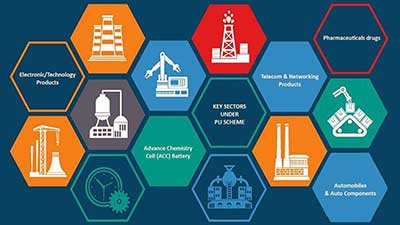GS-2: Government Policies & Interventions.
Key Phrases: PLI, CSS, CSSs, make in India, export oriented, Global supply chain.
Why in News:
- The Chemicals and Fertilisers Ministry has approved eight more companies including Globela Industries, Alta Laboratories, Sudarshan Pharma Industries, Aviran Pharmachem, KP Manish Global Ingredients, Alkimia Parma-chem and Honour Lab for the production-linked incentive (PLI) scheme in the Pharma Sector.
What is Production-Linked Incentive (PLI) Scheme?
- PLIs are essentially the incentives to companies to boost product. They could be in the form of tax rebates, import and export duty concessions, or maybe easier land-acquisition terms. Generally, the benefits of a PLI scheme are passed on to the final consumers of the goods in terms of lower prices.
When was it Launched?
- The scheme was notified in April 2020 as a Central Sector scheme for the Large-Scale Electronics Manufacturing.
- This was notified with the objective of providing the financial incentives for domestic manufacturing of goods. The scheme also seeks to attract large investments.
- It was initially launched for the domestic manufacturing of Mobile Phones and Specified Electronic Components.
Inventive Offered Under PLI Scheme:
- This scheme provides 4% to 6% incentive on incremental to the eligible companies who are manufacturing goods for 5 years period.
- The companies that are registered in India and involved in the manufacturing of goods are covered under the Target Segments of the scheme. Under the Scheme, companies will get incentives on incremental sales from products manufactured in domestic units.
- The scheme is implemented by the concerned ministries/departments, which shall act as a Project Management Agency (PMA) and be responsible for providing secretarial, managerial and implementation support and carrying out other responsibilities as assigned by Government from time to time.
Central Sector Schemes and Centrally Sponsored Schemes
- Central Sector Schemes are the schemes that are entirely and directly funded and executed by the central government. The schemes are formulated by the Centre, based on subjects from the Union List. Besides, there are some other programmes that various Central Ministries implements directly in States and UTs which also comes under Central Sector Schemes. In these schemes, the financial resources are not shifted to states
- Centrally Sponsored Schemes (CSSs) are special purpose grants (or loans) extended by the Central Government to States to encourage and motivate State governments to plan and implement programmes that help attain national goals and objectives.
Is there a need for Production-Linked Incentive (PLI) Scheme
- The idea of PLI is important as the government cannot continue making investments in these capital intensive sectors as they need longer times for start giving the returns.
- The electronics and pharmaceuticals themselves are large sectors and if the government can focus on labour intensive sectors like garments and leather, it would be really helpful.
Sectors covered in this scheme:
- Large Scale Electronics Manufacturing: Ministry of Electronics and Information Technology
- Key Starting Materials (KSMs)/Drug Intermediates (DIs) and Active Pharmaceutical Ingredients (APIs): Department of Pharmaceuticals
- Manufacturing of Medical Devices: Department of Pharmaceuticals
- Electronic/Technology Products: Ministry of Electronics and Information Technology
- Pharmaceuticals drugs: Department of Pharmaceuticals
- Telecom & Networking Products: Department of Telecommunications
- Food Products: Ministry of Food Processing Industries
- White Goods (ACs & LED): Department for Promotion of Industry and Internal Trade
- High-Efficiency Solar PV Modules: Ministry of New and Renewable Energy
- Automobiles & Auto Components: Department of Heavy Industry
- Advance Chemistry Cell (ACC) Battery: Department of Heavy Industry
- Textile Products: MMF segment and technical textiles: Ministry of Textiles
- Specialty Steel: Ministry of Steel
- Drones and Drone Components: Ministry of Civil Aviation
Advantages of Production Linked Incentive (PLI) Scheme:
- Make domestic manufacturing competitive and efficient.
- Generate new jobs.
- Spur entrepreneurship and attract new talents.
- Create economies of scale.
- Make India a part of the global supply chain.
- Attract FDI as fresh investments in the automotive sector.
- Enhance exports manifold in the long run.
Challenges associated with the PLI Schemes:
- Incompatibility with the World Trade Organization norms could arise if the PLI scheme is not in line with boosting global exports and value addition.
- The PLI scheme must be kept temporary – as these incentives could slow down growth in the 10 benefiting industries if they are continued for an extended period.
- The scheme contains a financial cap on incentives. This makes an over-performing company not to reap the benefits of it’s over achievements.
Way forward:
- Thus, the PIL scheme is born out of the necessity to make a strategic change to scale, competitiveness, market access and management capabilities to be global champions. This will further help the domestic players to garner more market share in India and globally as the world is looking at alternative sourcing away from china.
Source:
The Hindu BL
Mains Question:
Q. What is Production Linked Incentive (PLI) Scheme? How it make India a part of
the global supply chain?









